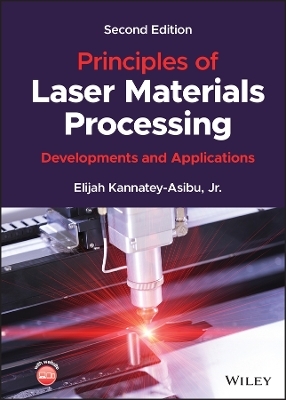
Principles of Laser Materials Processing
John Wiley & Sons Inc (Verlag)
978-1-119-88160-5 (ISBN)
Principles of Laser Materials Processing goes over the most recent advancements and applications in laser materials processing, with the second edition providing a welcome update to the successful first edition through updated content on the important fields within laser materials processing. The text includes solved example problems and problem sets suitable for the readers’ further understanding of the technology explained.
Split into three parts, the text first introduces basic concepts of lasers, including the characteristics of lasers and the design of their components, to aid readers in their initial understanding of the technology. The text then reviews the engineering concepts that are needed to analyze the different processes. Finally, it delves into the background of laser materials and provides a state-of-the-art compilation of material in the major application areas, such as laser cutting and drilling, welding, surface modification, and forming, among many others. It also presents information on laser safety to prepare the reader for working in the industry sector and provide practicing engineers the updates needed to work safely and effectively.
In Principles of Laser Materials Processing, readers can expect to find specific information on:
Laser generation principles, including basic atomic structure, atomic transitions, population distribution, absorption, and spontaneous emission
Optical resonators, including standing waves in a rectangular cavity, planar resonators, beam modes, line selection, confocal resonators, and concentric resonators
Laser pumping, including optical pumping, arc/flash lamp pumping, energy distribution in the active medium, and electrical pumping
Broadening mechanisms, including line-shape functions, homogeneous broadening such as natural and collision, and inhomogeneous broadening
Principles of Laser Materials Processing is highly suitable for senior undergraduate and graduate students studying laser processing, and non-traditional manufacturing processes; it is also aimed at researchers to provide additional information to be used in research projects that are to be undertaken within the technology field.
Dr. Elijah Kannatey-Asibu, JR., PhD, received his PhD from the University of California at Berkeley, USA, in 1980. He is now Professor Emeritus of Mechanical Engineering at the University of Michigan in Ann Arbor, where he was Professor until 2020. His research focused on multi-sensor monitoring of manufacturing processes, multiple-beam laser processing, acoustic emission investigation of manufacturing processes, and microfabrication using femtosecond lasers.
PREFACE TO THE SECOND EDITION xxi
PREFACE TO THE FIRST EDITION xxiii
ABOUT THE COMPANION WEBSITE xxv
PART I PRINCIPLES OF INDUSTRIAL LASERS 1
1 Laser Background 3
1.1 Laser Generation 3
1.2 Optical Resonators 12
1.3 Laser Pumping 21
1.4 System Levels 24
1.5 Broadening Mechanisms 26
1.6 Beam Modification 29
1.7 Beam Characteristics 35
1.8 Summary 43
2 Types of Lasers 55
2.1 Solid-State Lasers 55
2.2 Gas Lasers 57
2.3 Semiconductor (Diode) Lasers 69
2.4 New Developments in Industrial Laser Technology 80
2.5 Summary 89
3 Beam Delivery 95
3.1 The Electromagnetic Spectrum 95
3.2 Birefringence 96
3.3 Brewster Angle 96
3.4 Polarization 98
3.5 Beam Expanders 101
3.6 Beam Splitters 102
3.7 Beam Delivery Systems 103
3.8 Beam Shaping 116
3.9 Summary 125
PART II ENGINEERING BACKGROUND 133
4 Heat and Fluid Flow 135
4.1 Energy Balance During Processing 135
4.2 Heat Flow in the Workpiece 136
4.3 Fluid Flow in Molten Pool 156
4.4 Summary 161
5 The Microstructure 175
5.1 Process Microstructure 175
5.2 Discontinuities 195
5.3 Summary 202
6 Solidification 209
6.1 Solidification Without Flow 209
6.2 Solidification with Flow 216
6.3 Rapid Solidification 221
6.4 Summary 222
7 Residual Stresses and Distortion 227
7.1 Causes of Residual Stresses 227
7.2 Basic Stress Analysis 232
7.3 Effects of Residual Stresses 237
7.4 Measurement of Residual Stresses 240
7.5 Relief of Residual Stresses and Distortion 250
7.6 Summary 252
PART III LASER MATERIALS PROCESSING 261
8 Background on Laser Processing 263
8.1 System-Related Parameters 263
8.2 Process Efficiency 272
8.3 Disturbances That Affect Process Quality 274
8.4 General Advantages and Disadvantages of Laser Processing 275
8.5 Summary 275
9 Laser Cutting and Drilling 279
9.1 Laser Cutting 279
9.2 Laser Drilling 308
9.3 New Developments 318
9.4 Summary 326
10 Laser Welding 335
10.1 Laser Welding Parameters 335
10.2 Welding Efficiency 344
10.3 Mechanism of Laser Welding 344
10.4 Material Considerations 355
10.5 Weldment Discontinuities 359
10.6 Advantages and Disadvantages of Laser Welding 360
10.7 Special Techniques 360
10.8 Specific Applications 371
10.9 Summary 382
11 Laser Surface Modification 391
11.1 Laser Surface Heat Treatment 391
11.2 Laser Surface Melting 413
11.3 Laser Direct Metal Deposition 414
11.4 Laser Physical Vapor Deposition (LPVD) 419
11.5 Laser Shock Peening 420
11.6 Laser Texturing 427
11.7 Summary 429
12 Laser Forming 437
12.1 Principle of Laser Forming 437
12.2 Process Parameters 439
12.3 Laser-Forming Mechanisms 439
12.4 Process Analysis 443
12.5 Advantages and Disadvantages 447
12.6 Applications 448
12.7 Summary 448
13 Additive Manufacturing 453
13.1 Computer-Aided Design 453
13.2 Part Building 462
13.3 Post-Processing 477
13.4 Applications 478
13.5 Advantages and Disadvantages 480
13.6 Summary 480
14 Medical and Nanotechnology Applications of Lasers 485
14.1 Medical Applications 485
14.2 Nanotechnology Applications 490
14.3 Summary 494
15 Sensors for Process Monitoring 497
15.1 Laser Beam Monitoring 497
15.2 Process Monitoring 504
15.3 Summary 522
16 Processing of Sensor Outputs 527
16.1 Signal Transformation 527
16.2 Data Reduction 532
16.3 Pattern Classification 534
16.4 Summary 550
17 Laser Safety 557
17.1 Laser Hazards 557
17.2 Laser Classification 562
17.3 Preventing Laser Accidents 563
17.4 Summary 569
Appendix 17.A 571
Problem 572
Bibliography 572
Index 573
| Erscheinungsdatum | 12.01.2023 |
|---|---|
| Verlagsort | New York |
| Sprache | englisch |
| Gewicht | 1678 g |
| Themenwelt | Technik ► Elektrotechnik / Energietechnik |
| ISBN-10 | 1-119-88160-9 / 1119881609 |
| ISBN-13 | 978-1-119-88160-5 / 9781119881605 |
| Zustand | Neuware |
| Informationen gemäß Produktsicherheitsverordnung (GPSR) | |
| Haben Sie eine Frage zum Produkt? |
aus dem Bereich


